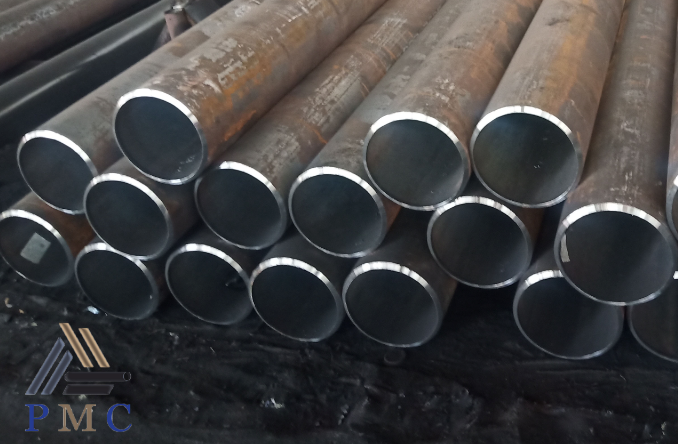
Hot Rolled Seamless Steel Pipe
Advantages:
It can destroy the casting structure of the steel ingot, refine the grains of the steel, and eliminate the defects of the microstructure, so that the steel structure is compact and the mechanical properties are improved. This improvement is mainly reflected in the rolling direction, so that the steel is no longer isotropic to a certain extent; the bubbles, cracks and looseness formed during casting can also be welded under the action of high temperature and pressure.

Disadvantages:
1. After hot rolling, non-metallic inclusions (mainly sulfides and oxides, as well as silicates) inside the steel are pressed into thin slices and delamination (interlayer) occurs. The delamination greatly deteriorates the tensile properties of the steel in the thickness direction, and there may be interlayer tearing when the weld shrinks. The local strain induced by the shrinkage of the weld often reaches several times the yield point strain, which is much larger than the strain caused by the load;
2. Residual stress caused by uneven cooling. Residual stress is the stress of internal self-phase balance without external force. Hot-rolled steel sections of various cross sections have this type of residual stress. The larger the section size of the general steel section, the greater the residual stress. Although the residual stress is self-balanced, it still has a certain influence on the performance of the steel member under the action of external forces. Such as deformation, stability, fatigue resistance, etc. may have adverse effects.
3. Hot rolled steel products are not easy to control in terms of thickness and side width. We are familiar with thermal expansion and contraction. Since hot rolling at the beginning even if the length and thickness are up to standard, there will be a certain negative difference after cooling. The wider the negative difference is, the thicker the thickness is, the more obvious it is. So for large steel, the width, thickness, length, angle, and edge of the steel cannot be too precise. Hot-rolled seamless steel pipes are divided into general steel pipes, low and medium pressure boiler steel pipes, high pressure boiler steel pipes, alloy steel pipes, stainless steel pipes, petroleum cracking pipes, geological steel pipes and other steel pipes.
Hot-rolled seamless steel pipes are divided into general steel pipes, low and medium pressure boiler steel pipes, high pressure boiler steel pipes, alloy steel pipes, stainless steel pipes, petroleum cracking pipes, geological steel pipes and other steel pipes.
Cold-rolled seamless steel pipes include general steel pipes, low and medium pressure boiler steel pipes, high-pressure boiler steel pipes, alloy steel pipes, stainless steel pipes, petroleum cracking pipes, and other steel pipes, but also include carbon thin-walled steel pipes, alloy thin-walled steel pipes, Stainless steel thin-walled steel pipe and special-shaped steel pipe. The outer diameter of the hot-rolled seamless pipe is generally greater than 32mm, the wall thickness is 2.5-75mm, the outer diameter of the cold-rolled seamless steel pipe can be 6mm, the wall thickness can be 0.25mm, the outer diameter of the thin-walled pipe can be 5mm, and the wall thickness is less than 0.25mm Cold rolling has higher dimensional accuracy than hot rolling.
Generally used seamless steel pipe: It is made of hot-rolled or cold-rolled low-alloy structural steels such as 10, 20, 30, 35, 45 and other high-quality carbon steel 16Mn, 5MnV and other low alloy structural steels or alloy steels such as 40Cr, 30CrMnSi, 45Mn2 and 40MnB. Seamless pipes made of low carbon steel such as 10 and 20 are mainly used for fluid transportation pipelines. Seamless tubes made of medium carbon steel such as 45 and 40Cr are used to manufacture mechanical parts, such as stressed parts of automobiles and tractors. Generally, seamless steel tubes are used to ensure the strength and flattening test. Hot rolled steel tubes are delivered in hot rolled or heat treated state; cold rolled steel tubes are delivered in heat treated state.
Allowable deviation of standardized outer diameter:
D1 ± 1.5%, minimum ± 0.75 mm
D2 ± 1.0%. ± 0.50 mm
D3 ± 0.75%, minimum ± 0.30 mm
D4 ± 0.50%. ± 0.10 mm
Steel pipe weight calculation formula
[(Outer diameter-wall thickness) * wall thickness] x0.02466 = kg / m (weight per meter)
Functional use
1. There are many types of construction: the pipeline underneath is the most, the groundwater is extracted when building is built, and the boiler is used for hot water transportation.
2. Mechanical processing, bearing sleeves, processing machinery parts, etc.
3. Electrical: gas pipelines for fluid transportation and hydropower
4. Anti-static tubes for wind power plants, etc.
Tips: ASTM A53 Gr.B is the grade in ERW high frequency welded pipe, divided into A and B grades. ASTM is only a set of specifications. ASTM steel pipe A53 A corresponds to the Chinese standard GB8163 raw material is 10# steel, and A53 B corresponds to the Chinese standard GB8163 raw material 20#.
For example: ASTM (standard) A53 (grade) gr is grade (abbreviation of grade) b (grade B)


